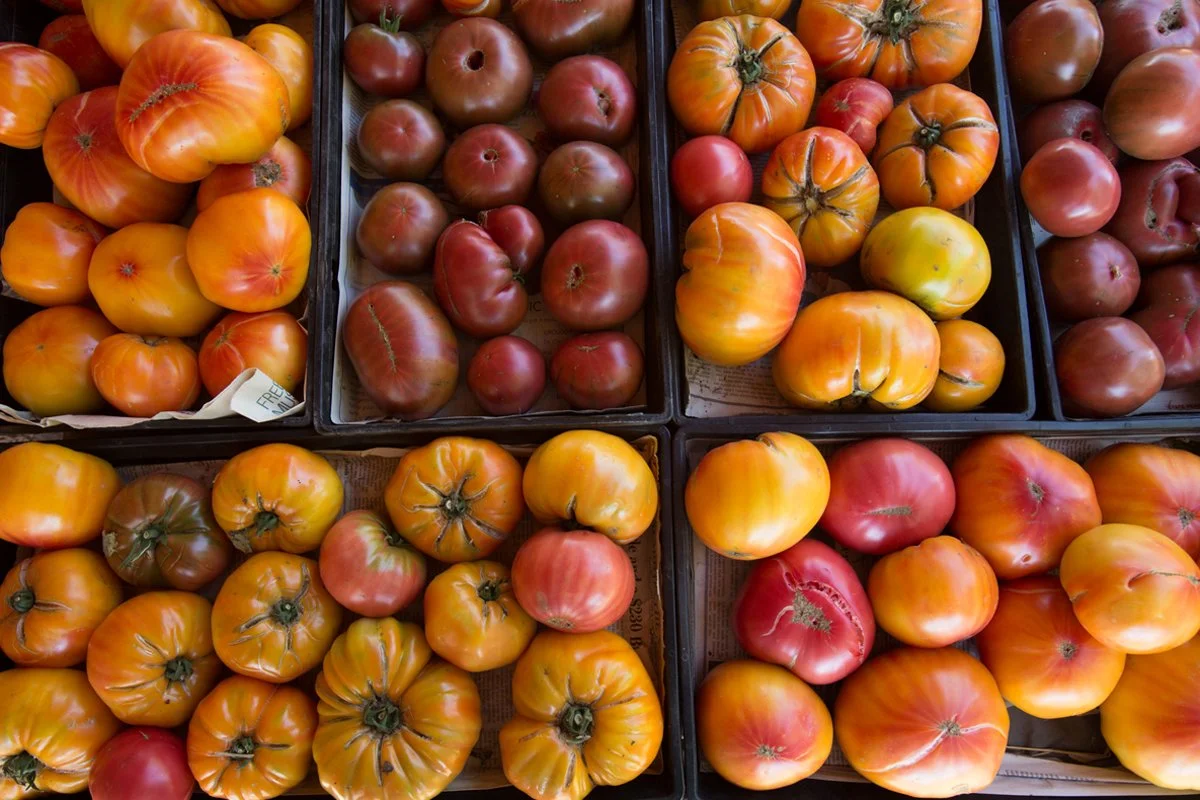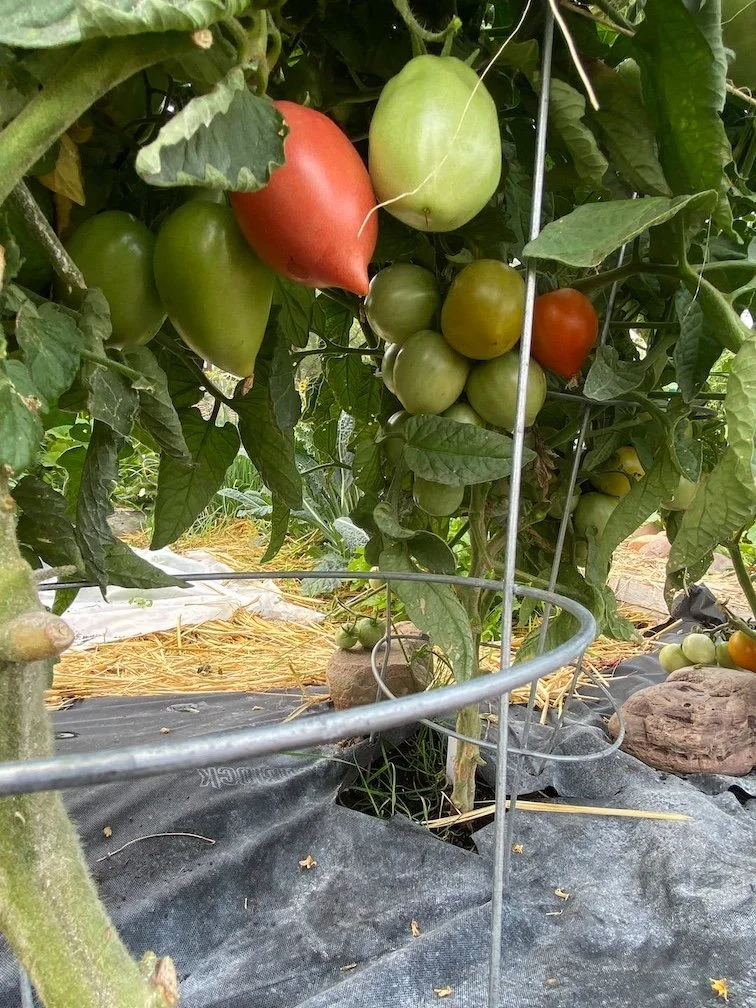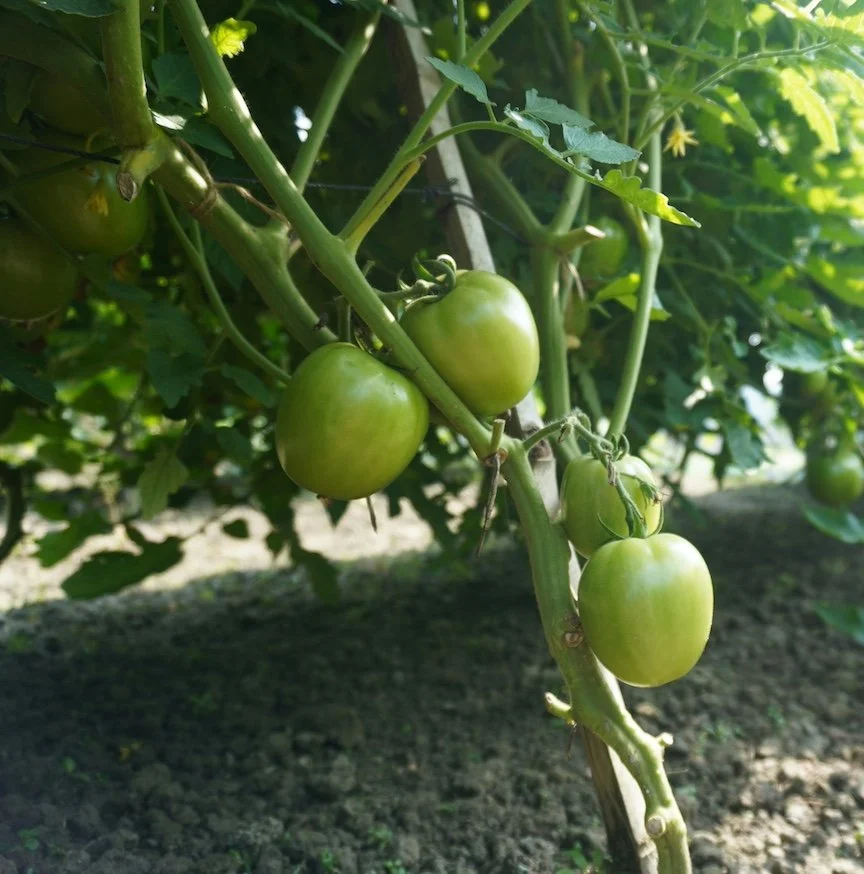Tomato Gardening Made Easy: Varieties, Soil, and Care
Heirloom tomatoes at the PEAS Farm in their abundant August glory.
Whether you start your tomatoes from seed or buy starts from your favorite nursery or organic grower at the local farmer's market, growing tomatoes can be easy and rewarding! Tomatoes are resilient, and with a few simple steps on your end, you will ensure a bountiful harvest.
Choosing Varieties
Tomatoes are a versatile fruit that can be used in a variety of ways. Whether you enjoy slicing tomatoes for fresh salads and sandwiches, snacking on cherry tomatoes, or using paste tomatoes for homemade sauces and canning, the options are endless. Maybe you're like me and want them all. Paste tomatoes like Romas and San Marzanos are smaller, denser, and have less liquid and pulp than the juicy Brandywine's and Beefsteaks, which are perfect for that classic summer BLT. However, some of the most coveted tomatoes, like San Marzano's and Beefsteaks, require 75-90 days to mature, and our growing season is short.
If you want your tomatoes to ripen before the temperatures fall, choose tomato varieties suited to short seasons and higher elevations. These varieties usually mature within 45-65 days. However, our gardening season has grown longer over the past few decades, and more gardeners are succeeding with tomatoes requiring more mature time.
Read about short-season varieties
Heirloom plants come from saved seeds that have been handed down for generations. These plants are not hybridized for commercial growth, which makes them superior in taste and color, but they can be less resistant to disease than hybrid tomatoes. Cherry tomatoes, slicing tomatoes, and canning/sauce tomatoes are all available as heirlooms. You can save seeds from your favorite heirloom varieties to grow the following year, keeping the tradition of heirloom plants alive and maintaining their unique flavors and characteristics.
Learn about saving tomato seeds.
Determinate and Indeterminate
Determinate
It's essential to consider the differences between determinate and indeterminate tomatoes. Determinate tomatoes grow to a predetermined height, from 2 to 3 feet tall. Their compact size makes them ideal for small spaces and pots, and they rarely require staking. However, I use small tomato cages with stakes to protect them from the Missoula wind. Determinates thrive in cool climates because they ripen quickly. You'll find many paste and sauce tomatoes and some delicious slicing tomatoes in determinate varieties.
Determinate tomato plant with bottom leaf branches trimmed. Photo by Marnie Craig.
Indeterminate tomato plant with bottom leaf branches trimmed. Photo by Marnie Craig.
Indeterminate
Indeterminate tomato plants are a great choice for gardeners who want to enjoy fresh tomatoes throughout the entire growing season. These plants will continue to grow and produce fruit until the first frost arrives. Due to their tall stature, indeterminate tomato plants require support systems like cages or stakes and may need pruning and tying up heavy branches. Most cherry and slicing/eating tomato varieties fall under the category of indeterminate tomato plants.
Soil Prep and Feeding
It's essential to provide tomatoes with nutrient-dense soil. Fortunately, there are many natural organic fertilizers to help you achieve this:
Blood meal is an excellent source of nitrogen
Bone meal is rich in phosphorous
Epsom salt can provide your plants with magnesium
Chopped banana peels ground eggshells are great sources of potassium
Composted organic material and well-composted manure can provide your plants with micronutrients and organic matter
These organic fertilizers release nutrients slowly over a long period of time, which is exactly what tomato plants need to grow and thrive. Alternatively, you can also find organic granular tomato foods that contain these essential nutrients.
Planting: When, where, and how
When: Tempurature and last frost date
Here’s a tomato sucker. Trim it! Photo by Marnie Craig.
You can safely transplant tomatoes when night temperatures are consistently above 55° (safest recommendations suggest two weeks after the last frost date — May 19 in Missoula). However, this may vary depending on the weather conditions. Last year, I transplanted my tomatoes on May 15, but this year is cooler, so I might wait until closer to June.
Ideally, tomatoes thrive in temperatures above 65° and can handle temperatures below 55°, but if the temperature drops to 40°, they may show signs of cold damage. To ensure your tomato plants are ready for transplanting, harden off your starts by gradually exposing them to the outdoors for at least a week or two before transplanting them into the ground.
Where & How: location & pruning
For optimal growth, choose the right location for your tomato plants. Indeterminate varieties should be planted where they won't shade other plants and where they have plenty of room to sprawl. Compact determinate varieties will thrive on the south edge, where they can enjoy the full sun. Slightly raised hills or rows with a furrow for watering allow roots to soak up water. Dig in some compost and composted manure wherever you plant your tomatoes.
Initially, we need to focus on establishing a strong root system. To do this, pinch off the lower leaves and any flowers. Plant your tomatoes deep, in holes with a good mixture of the nutrients mentioned above. This way, the underground stem will be able to grow roots and establish a strong foundation. It's important to continue nipping off any flowers for at least two weeks after planting to encourage the plant to focus its energy on root growth rather than producing fruit too soon. A strong root system will ultimately lead to a more abundant harvest. Be sure to water deeply.
Watering and Feeding
After the initial watering, water deeply every 3-5 days, depending on temperatures, letting the soil dry out between watering. Once the fruit is on the vine, avoid sprinkling the fruit with water in the hot sun, and be sure to water on a consistent schedule to help prevent cracking and splitting. Don't mulch your tomatoes. Montana is cool, and tomatoes need warm soil that dries out between watering.
After four weeks, it's time to give your tomatoes a boost. You can side-dress the plants with an organic, low-nitrogen granular tomato food or a mixture of potassium and phosphorus (composted manure, bonemeal, and banana peel tea).
Side-dress again in another four weeks. To side-dress, create a slight furrow 4-6 inches away from the plant stem and bury in the nutrients. Indeterminates benefit from a side dressing of nutrients every four weeks, but determinates stop drawing nutrients from the soil once their fruit is set.
Pruning: Optional but helpful
Not only does pruning help prevent ground pests from accessing leaves and fruit lying on the ground, it allows more plant energy to go to the fruit. It's always a good idea to remove suckers. Suckers are side shoots that grow from the point between the main stem and a branch. Removing the lower leaf branches up to 10" off the ground for indeterminates and 6" to 8" for determinates is a good guide. You can prune your indeterminate tomatoes often and extensively but don't cut the tops off your determinant plants. While many people don't prune their plants and still get beautiful tomatoes, the fruit may ripen slower than on pruned plants. Ultimately, the level of hands-on management you provide is a personal choice.
One day’s harvest of short season tomatoes! Photo by Marnie Craig.
Encourage Ripening
At the beginning of August, trim off most of the non-fruit-bearing leaf branches that aren't directly shading the fruit. This forces the plant's energy to go into ripening the fruit. Large heavy-moisture tomatoes require more protection from the sun, so be sure to leave shading leaves or cover them with a light sheet or shade cloth when temperatures are above 90°.
Early to mid-August, pinch off new flowers (not on cherry tomatoes) and remove the smallest tomatoes that won't have time to grow before the end of the season. This directs the plant’s energy into ripening the well-established tomatoes. Cutting back on watering will also signal to the plants that they need to ripen their fruit.
If you have a lot of fruit that isn't ripening at the end of the season, some simple tricks can encourage them to ripen faster. The hormones that ripen tomatoes prefer 65° - 75° and will go dormant in high heat or cooler temperatures. When it's too hot, tomatoes will turn red, but the ripening hormones are inactive, and the tomatoes won't be as sweet. However, you can pick them as they begin to turn color and bring them inside to finish ripening. Use snippers and keep the stem attached. Inside, where optimal temperatures don't fluctuate much, the hormone will reactivate, and you will get tasty ripe fruit. I use this trick every year, and it always works. However, nothing is better than when conditions allow our tomatoes to vine ripen.





